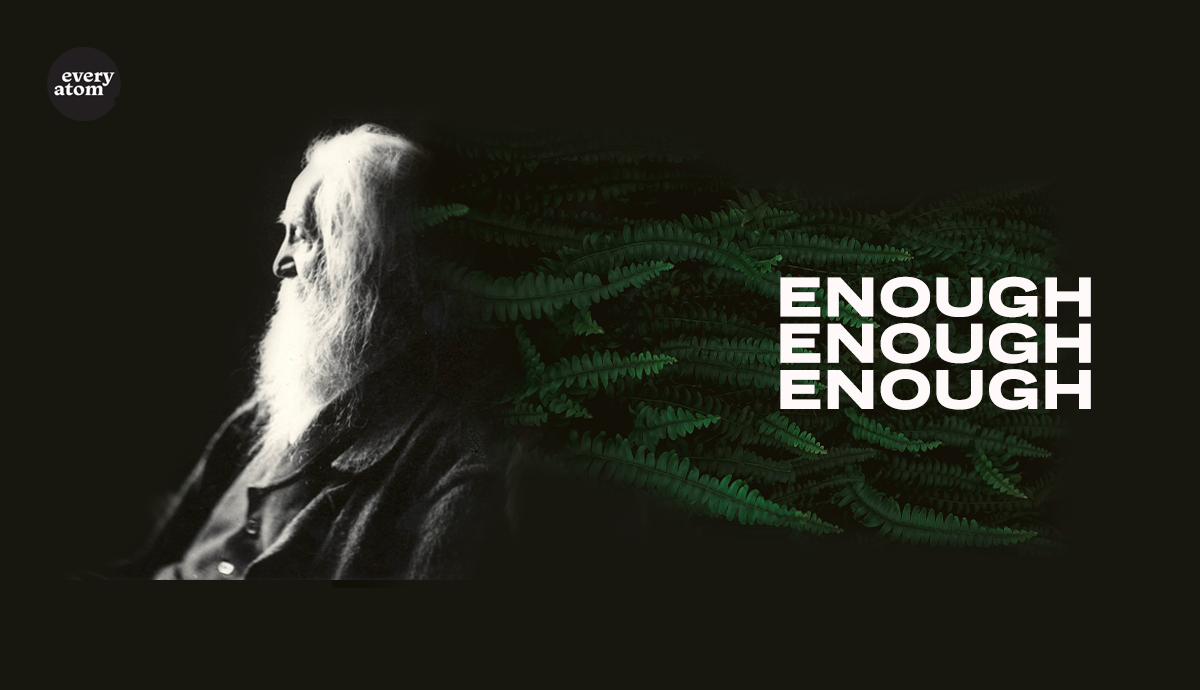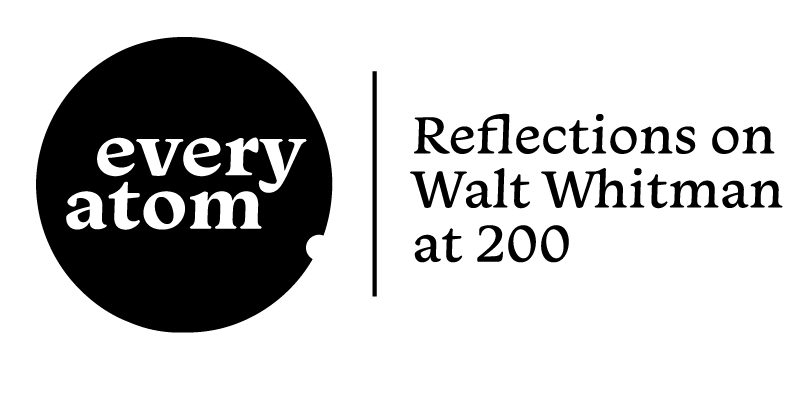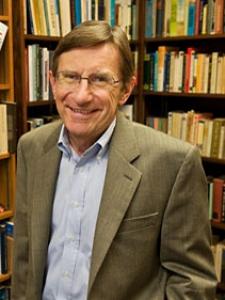Every Atom | No. 200
Introduction to Every Atom by project curator Brian Clements
This line marks the major turning point in the 1855 poem that would become “Song of Myself.” Emphatic as it is, with its exclaimed warning to the reader to watch out, Whitman sensed that it was not emphatic enough. And so, as he revised the poem, he eventually prefaced this line with what became the most emphatic line in the poem—a repeated triple exclamation: “Enough! Enough! Enough!” That is the line I now hear rising up off the page as I write this final entry for North American Review’s Every Atom project, two hundred days into the Third Whitman Century, after 199 others have written their own responses to Whitman’s endlessly fertile poem. “Enough!” Walt says: “Enough! Enough!”
But there’s simply no stopping us. Brian Clements developed and organized this catalog of responses to honor the bicentennial of Whitman’s birth by inviting a vast and diverse mix of people—poets and critics and photographers and filmmakers and singers and any number of others, from across the U.S. and internationally—to respond to a word or line or passage in “Song of Myself” and thereby create, for the first 200 days following Whitman’s 200th birthday, a Whitmanian catalog of readers talking back to the poet, just as he demanded (“Will you speak before I am gone?”). The ongoing cascade of responses could continue for another 200 days, or 365 or 2000 days, and in fact will go on for as long as Whitman is read, because that’s what he wrote his poetry for: to be talked back to, argued with, always put into active dialogue. Like Whitman’s own catalogs in “Song of Myself,” Every Atom has become a long and ultimately random representative sampling—a gesture toward democratic completeness. Enough!
What led Whitman to insert that triple exclamation in “Song of Myself”? The longest catalog in Whitman’s poem is in what became Section 33, which begins with the “I” cutting his “ties and ballasts” and rising, like a hot-air balloon, over the earth, “skirt[ing] sierras,” “palms cover[ing] continents, . . . afoot with my vision.” Then the torrent of that vast catalog begins: Whitman’s endlessly absorptive lines suggest an open database, a process of data ingestion that could go on for a lifetime. But toward the end of the catalog, things get darker, and death and suffering and pain take over; the “I” enters into the torture felt by martyrs, by “the hounded slave,” by “the mash’d fireman,” by dying soldiers. The next few sections then slow down and abandon cataloging to instead narrate historical accounts of death, loss, defeat, amputation, and failure. The “I” cannot help identifying himself fully with the desperately sick, the desperately poor, the desperately convicted, and the poet feels himself sapped of his strength and magnetism and energy, as he becomes isolated, ashamed, and repellent. He ends this section as a beggar: “I project my hat, sit shame-faced, and beg.”
Imagine if “Song of Myself” had ended here. It would be as if the whole democratic experiment that generated this poem had shattered, as the confident absorptive self stalls, now fully identified only with those who have succumbed to loss. The Whitmanian self here is no longer the expanding, celebratory, ever-widening soul, but rather a soul that has contracted into a being who, instead of projecting the self throughout the world can now only “project” his hat in an agonized and humiliating gesture of abjection:
Not a cholera patient lies at the last gasp, but I also lie at the last gasp,
My face is ash-color'd, my sinews gnarl . . . . away from me people retreat.
Askers embody themselves in me, and I am embodied in them,
I project my hat, sit shame-faced and beg.
The poem feels as if it could end here at a bleak dead stop. But then, suddenly, the “I” revives: “Somehow I have been stunn’d. Stand back!” Look out, old Whitman is back! It’s a section of the poem that still makes me gasp when I read it aloud. Instead of ceasing in silence and abjection, the poet now calls himself out of his isolation and despondency.
In the 1855 version of the poem, Whitman had not yet quite figured out how to signal the abrupt shift in the poem’s tone. He simply said, “I rise extatic through all,” but by 1860 he had added a line to more clearly alert readers to the suddenness of the turn: “Enough—I bring such to a close, / I rise extatic through all. . . .” But even this single “Enough” was not enough to activate the dramatic resurgence that follows. So, in 1867, after the Civil War ended and Whitman knew that he and his broken nation were now going to have to absorb and from now on live with and even build a future out of the mass death and loss and grief and depression that permeated the teetering nation, he brought out the exclamation points and the repetition:
Enough! enough! enough!
Somehow I have been stunn’d. Stand back!
Give me a little time beyond my cuff’d head, slumbers, dreams, gaping,
I discover myself on the verge of a usual mistake.
That I could forget the mockers and insults!
That I could forget the trickling tears and the blows of the bludgeons and hammers!
That I could look with a separate look on my own crucifixion and bloody crowning.
I remember now,
I resume the overstaid fraction,
The grave of rock multiplies what has been confided to it, or to any graves,
Corpses rise, gashes heal, fastenings roll from me.
I troop forth replenish’d with supreme power, one of an average unending procession,
Inland and sea-coast we go, and pass all boundary lines,
Our swift ordinances on their way over the whole earth,
The blossoms we wear in our hats the growth of thousands of years.
Eleves, I salute you! come forward!
Continue your annotations, continue your questionings.
Yes, he realizes, we must recognize the death, suffering, sickness, pain, and abjection in the world, but we must also realize that, horrific as it may at times seem, that dark side of life is never the whole story. We may be stunned by the terrors we encounter, the pain we witness, the hundreds of thousands of young men we had to bury in four short years, but we must rise again from this abjection and carry on into the future, build a future out of death (as all futures must be built).
The poet finds himself, then, “on the verge of a usual mistake”—the error of mistaking the mockery and insults and tears and blows as the essential meaning of life. “I resume the overstaid fraction,” he says, acknowledging that when we encounter the most painful parts of experience, they can come to seem all-consuming, as we forget the generative aspects of life. Those positive experiences form the majority of life’s moments, he tells us, even if, during bleak times, that larger fraction can be eclipsed and lost for a while. The poet now reclaims this fraction that has stayed away too long. And, as he does so, he evokes the story of Christ’s resurrection in a remarkably secular way: we all experience a “crucifixion and bloody crowning.” We all bear a cross, wear a crown of thorns, and we all must learn—as Whitman has been instructing us in this poem—to take on, recognize, seek to know the suffering and pain of others. We recall that Whitman’s original title for his poem “This Compost” was “Poem of the Resurrection of the Wheat”: for Whitman, resurrection was the life that incessantly grows—as all life has and always will—out of death.
So the poet is now ready to “troop forth replenish’d with supreme power, one of an average unending procession”; he is not a divine figure in the sense of being more pure or closer to God than anyone else. The nature of democracy is that we are all equally close to God in that we are all part of one ongoing democratic development, with the divine in each and every individual, average and unending as we proceed to the future. So he calls us together—his “eleves,” his argumentative pupils (Whitman uses the French perhaps as a nod to the active role of students who stood up to and helped topple antidemocratic forces in the 1848 French Revolution)—to continue with him on this poetic journey, to make notes, and most of all, as we go forward, to question—always, vitally, to question and challenge.
It sounds like he’s talking to us, doesn’t it? Two hundred days and two hundred responses into the 201st year since Whitman arose out of all the deaths that came before him, he cries out “Enough!” even as he commands us to “Continue your annotations, continue your questionings.” And, of course, we will. We always have. Beginning in Whitman’s own time, writers and artists and politicians and general readers have talked back to him incessantly, and the questioning and challenging and debating only increased after his death, as his poetry seemed to gain power when he could address those of us born after he died, we who had yet to emerge from death into life, “ever so many generations hence” (as he put it in “Crossing Brooklyn Ferry”), we the living whom Whitman had faith would be here when he wasn’t, with lungs and eyes and hands and brains, reading his words, talking back before it is too late. And the responses continue to proliferate. When Jim Perlman and Dan Campion and I were preparing the 200th Birthday Edition of Walt Whitman: The Measure of His Song, expanding the book to bring the long tradition of poets talking back to Whitman right up to the present, we read through hundreds of poems and essays written in the past decade by writers from around the world who have directly grappled with Whitman, doing precisely what Whitman told us democratic readers had to do: “the process of reading is not a half-sleep, but, in highest sense, an exercise, a gymnast’s struggle” in which the reader “must himself or herself construct indeed the poem, argument, history, metaphysical essay—the text furnishing the hints, the clue, the start or framework” (Democratic Vistas). The democratic reader never succumbs to the author(ity), and democratic authors know their work is always a collaboration with active (never passive) democratic readers. Far from waning, the number of responses to Whitman is growing exponentially in the twenty-first century.
Those of you who have been reading these two hundred responses faithfully know that they have hardly formed a unanimous group of celebrations of Whitman: many in fact have challenged him severely; some have ultimately rejected him. It is impossible to be athletic readers without occasionally cuffing the author’s head. An increasingly diverse “we” has wanted and needed more and more from Whitman, our poet of democracy, and it seems he has failed us in key ways. So what do we do? How do we respond? Langston Hughes, in the Chicago Defender in 1953, celebrated Leaves of Grass as the “greatest poetic statements of the real meaning of democracy ever made on our shores.” Then, the next week, a professor published a rebuttal to Hughes’s claim, noting Whitman’s various racist comments and arguing that Whitman was no friend of a diverse democracy. Hughes responded by acknowledging “Whitman’s American weaknesses in regard to race,” but he nonetheless held that Leaves of Grass “is a very great book, and one which Negroes or anyone else, for that matter, should read and remember, for its heart and essence are decency, and democracy, friendship and love for every human being.” Yes, Hughes admitted, we can scour Whitman’s prose and conversations and parts of his poetry and find much to criticize, “but if we let temporary human failings destroy for us the timeless values of the best of [his] work, we will have only [his] sins to contemplate. . . . Out of the best of his love, Whitman created the best of his poems. For these, all may be thankful.” Hughes’s view may sound a bit quaint nearly 70 years later, but the past 200 days have demonstrated that in fact many still do find much to admire and much to sustain them in “the best” of Whitman’s work.
To circle back from Day 200 to Day 1: Martín Espada opened the catalog of responses by writing of the best of Whitman’s work, his “sign of democracy” that declared him to be “the advocate for those excluded from democracy’s embrace,” “the prophet of the new politics and the new poetics.” Recently in Poetry (and on the Poetry Foundation website), Espada has written eloquently about the cruel irony of the fact that the bicentennial of Whitman’s birth has turned out to be celebrated during the Trump administration, and yet, he points out, Whitman fills a “great void . . . in the Age of Trump: sympathy is the essence of Whitman, and this is the human quality so sorely lacking in this sociopathic president, his authoritarian regime and its legions of supporters.” The “Whitman at 200” celebrations throughout this year have highlighted all the ways that this poet’s inclusive celebration of American democratic diversity stands in stark opposition to Trumpism, and yet Whitman’s own failures (along with virtually all major white writers of the nineteenth century) to articulate a vision of a biracial or multiracial society during the Reconstruction and post-Reconstruction years certainly haunts us today. America’s great democratic poet dragged with him, as do we all, the burdens of America’s racist past that we always seem only gradually and grudgingly to be fully recognizing let alone emerging from. As we live through a deeply regressive era in the nation’s history, Whitman has become more than ever a figure to be argued with, affirmed, denied, embraced, doubted, loved, but most of all read. “Continue your annotations, continue your questionings.”
Enough said. And yet . . .
Recommended
Nor’easter
Post-Op Appointment With My Father
Cedar Valley Youth Poet Laureate | Fall 2024 Workshop







